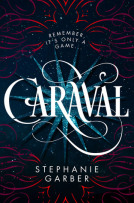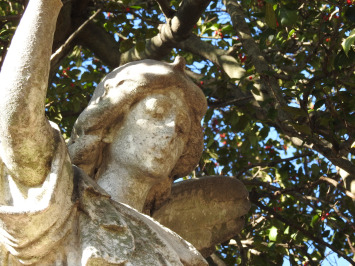by Mark Mitchell and Taylor Anderson
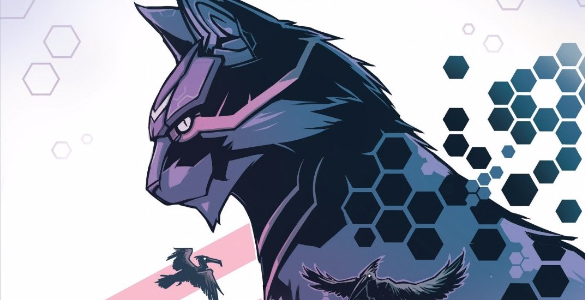
This article contains SPOILERS. If you haven’t read the issue yet, proceed at your own risk!

Mark: There’s no one-to-one mapping of the different species in Simon Spurrier and Caspar Wijngaard’s Angelic 3 onto our world. It’s not like the Monks represent Group X and the Mans represent Group Y. But at the same time, the world of Angelic is our world, and the experience of the Monks and the Mans is our experience.
None of the surviving factions inhabiting the world of Angelic understand the world they’re in. Some of them, like the Mans, are searching for the answers. Still, for every small piece of the puzzle in their possession, the issue makes it clear that they’re no closer to Truth. They don’t realize it, but understanding Truth is impossible since they lack a clear picture of what the completed puzzle should look like in the first place. And while the Monks have religion around which to order their world, Qora finds it unfulfilling. She’s different from the other Monks, and it’s a frightening feeling when everything you thought to be true is a hoax; without the guiding principles of the Monk teachings Qora is completely rudderless. Even when she has the opportunity to question an “angel” about her purpose in life, she finds the creature is just as clueless as she is; having been designed generations ago for some unknown purpose, the angel is now merely acting on programming — on instinct — with no thoughts of its own.
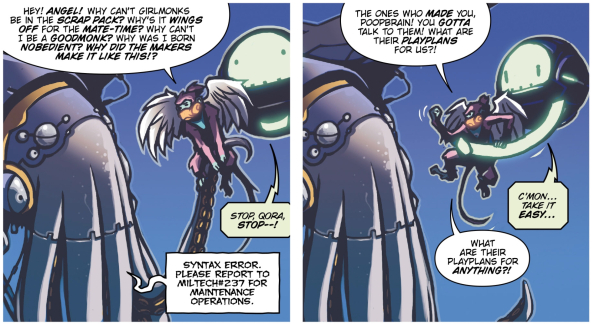
On the other hand, Complainer and the other Mans think they’re close to figuring it all out, and they’re becoming increasingly desperate and willing to hurt others in the pursuit of any information they think might help. But it seems apparent that the Eye they’re in search of is not the Rosetta Stone they expect it to be. Rather, any answers they find are only destined to introduce more questions. Plus, their motives don’t seem pure, and a little bit of information is more dangerous than ignorance.
One of Angelic 3’s strengths, and a strength of the entire series, is the methodical way in which Spurrier meters out bits of information about the world of Angelic, keeping readers engaged with the promise that answers will eventually be forthcoming. And maybe everything will eventually be revealed for readers, but wouldn’t it be fitting if it wasn’t? I can’t imagine that Qora and Complainer would ever truly be able to understand, anyways. Like us, even if the workings of the universe are laid out plainly, they don’t have the intelligence to fully comprehend it all. Even if Qora meets a human and learns the genesis of her species, how can she possibly understand humanity? How to explain the genesis of all of humanity’s existence in the first place? There’s no end to the questions facing Qora (and, really, all of us) in her search for her place in the universe.

But just because Qora may not ever fully understand her universe doesn’t mean her quest for answers is in vain. What drives each of us is a desire to find meaning in our own lives, and Qora doesn’t need to understand the world to be happy. She just needs to find something that fulfills her.
What’d you think, Taylor? Wijngaard delivers beautiful art issue after issue, and combined with Spurrier’s script, this book is one I look forward to every month. Are you as high on it as I am? And do you think you’ll be satisfied if Angelic ends without a clear explanation for how the world turned into the world of Monks and Mans?

Taylor: I’d totally be satisfied with an ending to this series that is open ended. What makes it so good, in fact, is precisely this aspect. Spurrier seems content to let his readers fill in the gaps so far when it comes guessing how the world of Angelic was created and that mystery is what makes it so riveting. Suppose that this mystery is never solved, and the series would still be just as good. That’s because Angelic rises above it’s narrative to relate a parable that is steeped in metaphor.
Qora’s search for answers illustrates this perefectly. Qora is driven by two opposing yet complimentary motives — her search for truth and her doubt. Qora’s doesn’t readily accept the myths about the gods that her fellow winged monkeys are so ready to believe in. This doesn’t mean she doesn’t believe in them, but she needs proof of their existence. When her adventures finally lead her to meet one face to face, her worst doubts seemed to be confirmed.
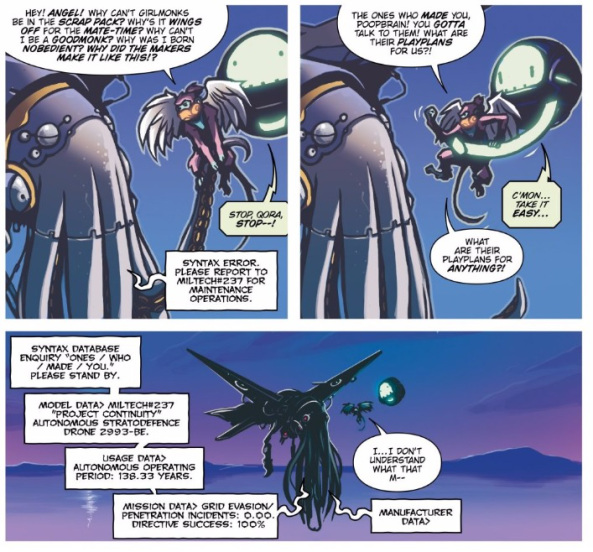
Speaking to the flying squid cyborg, Qora is confused when it reply to her queries with programming speak that might as well be Latin to her. At first Qora is curious but this soon gives way to despair as she can’t unravel the words the squid-angel is speaking to her. For a moment, she begins to doubt that the squid actually is an angel, but her fears are soon quelled when it launches a homing beacon that takes her one of the Makers’ labs.
This episode might ring all too familiar to anyone who has dabbled in religion, or any belief in some sort of higher power for that matter. Religion requires faith, so to be religious one has to confront their doubt at every turn. Qora does just this when she finds an angel only to be confused and dishearted by its message. This test of her faith is not unique to her own religious experience, but rather one that has plagued mankind for ages. Similarly, Qora finds a way to renew her faith when she finds the Makers’ lab. To her, this means the squid is an angel because it led her closer to her gods. In the same way, people have been justifying their religion and their doubts throughout history as well.
So what I see here is a story that is a parable for the religious experience, albeit in a nutshell full of cybernetic animals. This, in turn, is what makes Angelic vital. Almost everyone can relate to Qora’s search for truth and her belief in a higher power because it’s one of the very things that makes us human. This alone makes the series, and this issue, wonderful and makes any clear explanation of its world a tertiary concern.
And yeah, Wijngaard’s artwork is fantastic. What makes it such a perfect fit for this series is the way it blends the cuddly and cute with the horrific. Take, for instance, the scene when Qora and Complainer enter the Makers’ lab.

On the one hand, we have Qora pictured prominently at the bottom. Wijngaard lights up her face with happiness and hope, eschewing a more realistic portrayal of a monkey’s features in an effort to help humanize her. Additionally, she is inked with heavy outlines which are reminiscent of illustrations associated with picture books and other, more innocent genres. This portrayl is juxtaposed severely with the horrors of seeing toads, rats, parrots, and a monkey skeleton who are clearly unlucky remnants of experiments gone awry. These unlucky animals are drawn more realistically and with finer outlines which successfully conveys the horror of animal testing. This, paired with the well-detailed dilapidation which acts as backdrop in this scene, has allowed Wijngaard to capture both wonder and horror equally well on the same page.

For a complete list of what we’re reading, head on over to our Pull List page. Whenever possible, buy your comics from your local mom and pop comic bookstore. If you want to rock digital copies, head on over to Comixology and download issues there. There’s no need to pirate, right?
Advertisements Share this:

